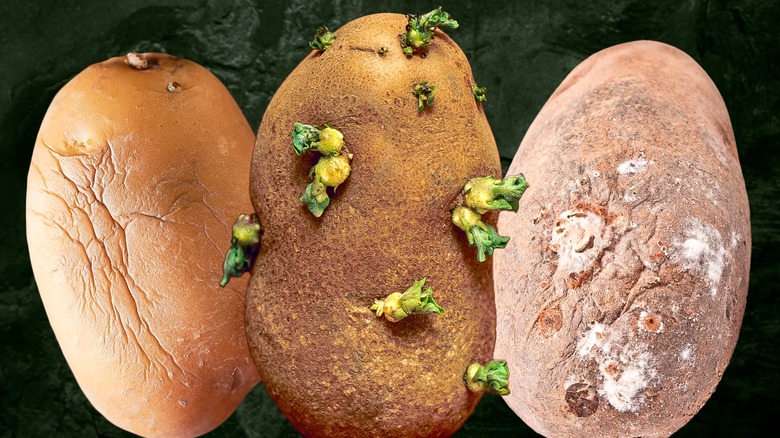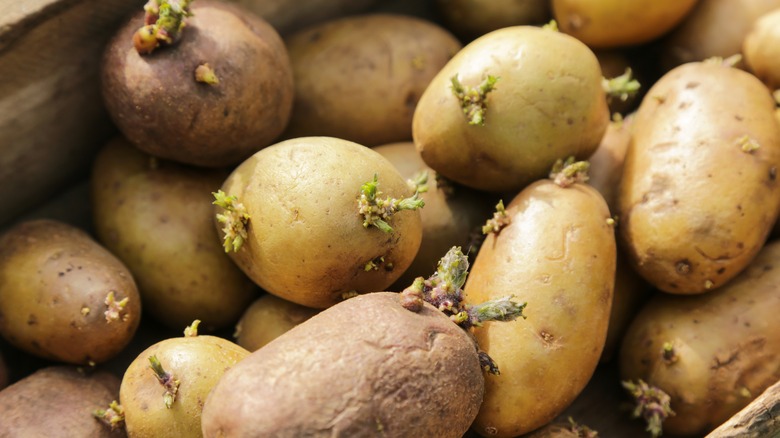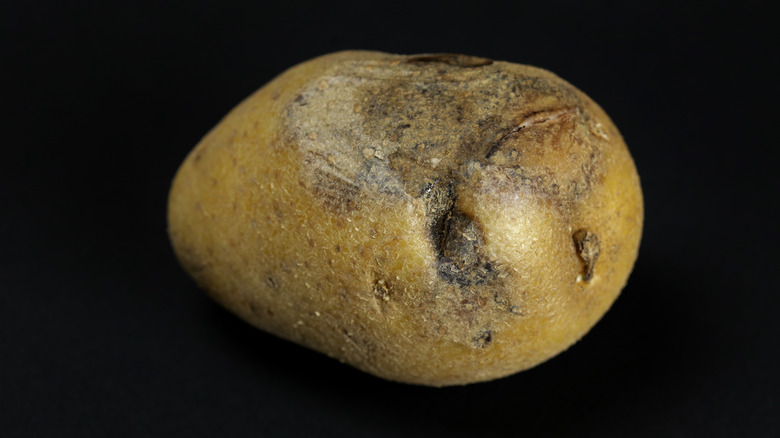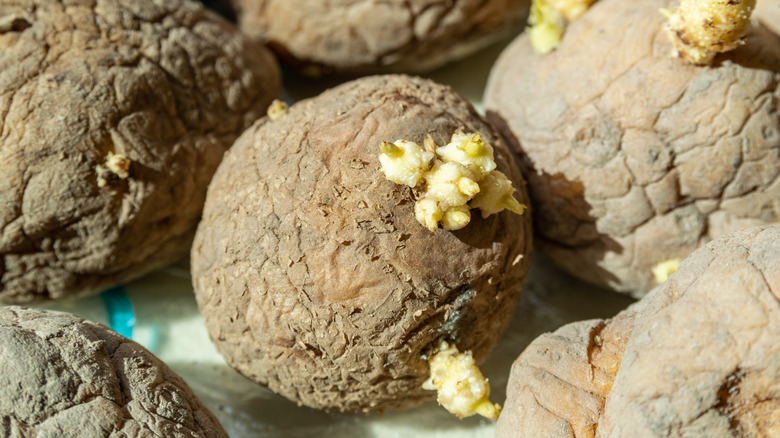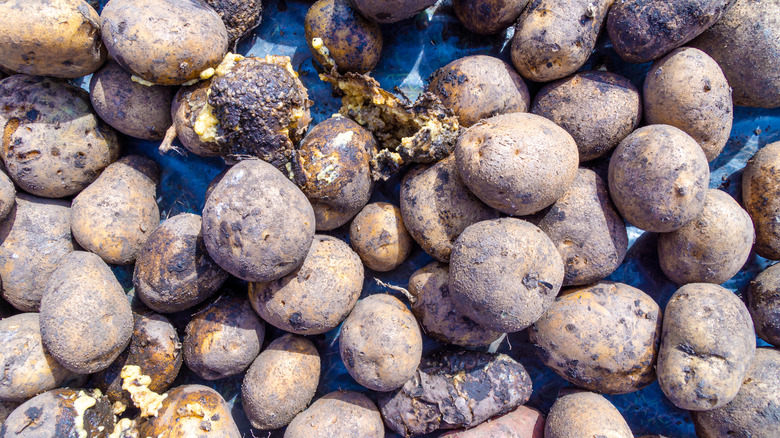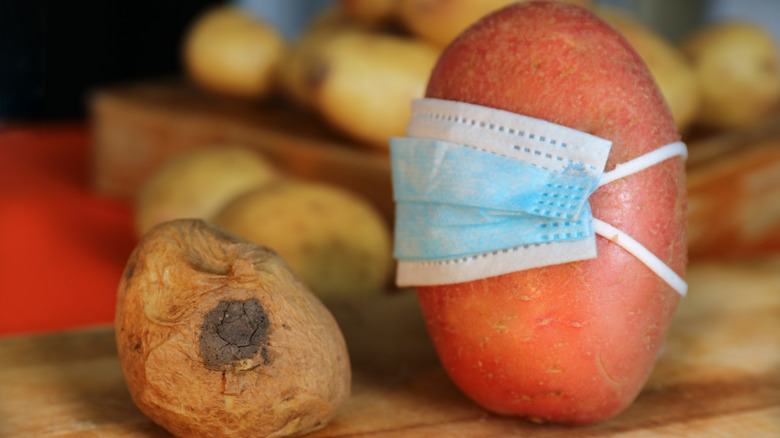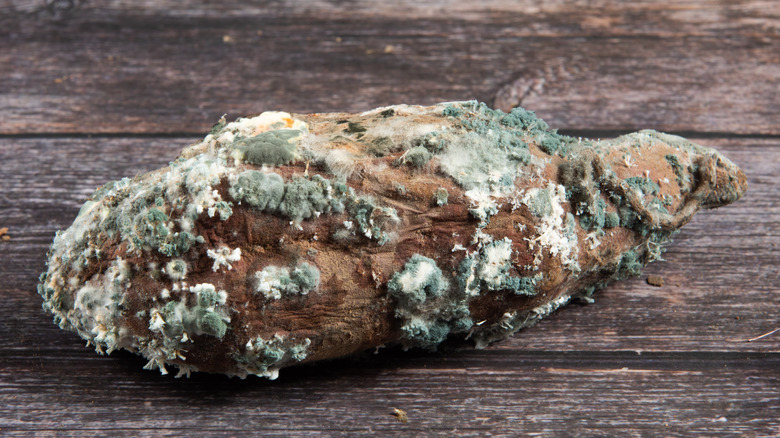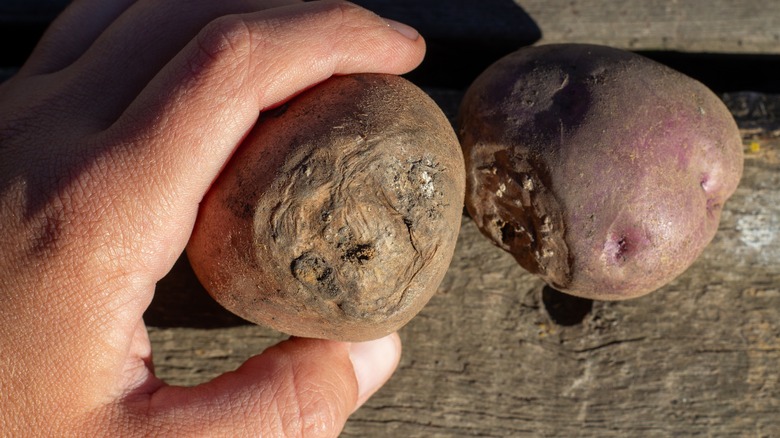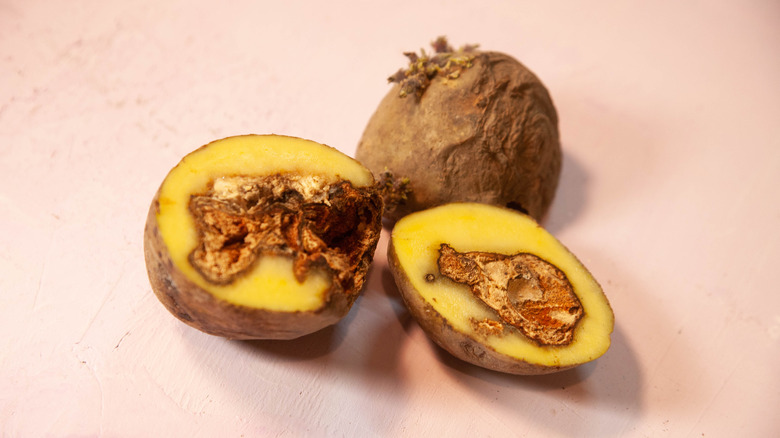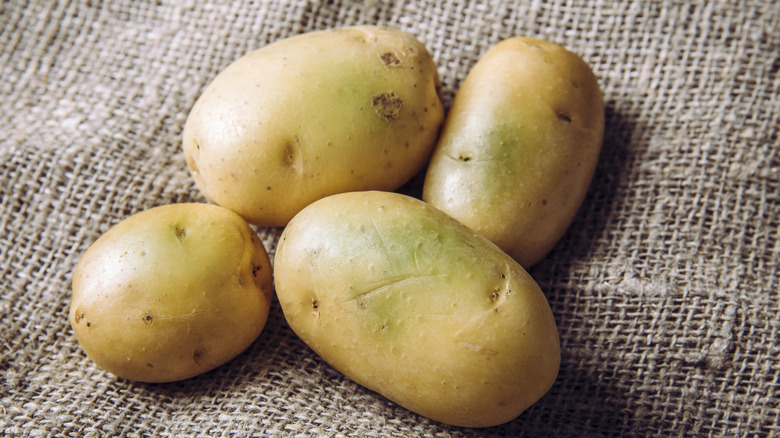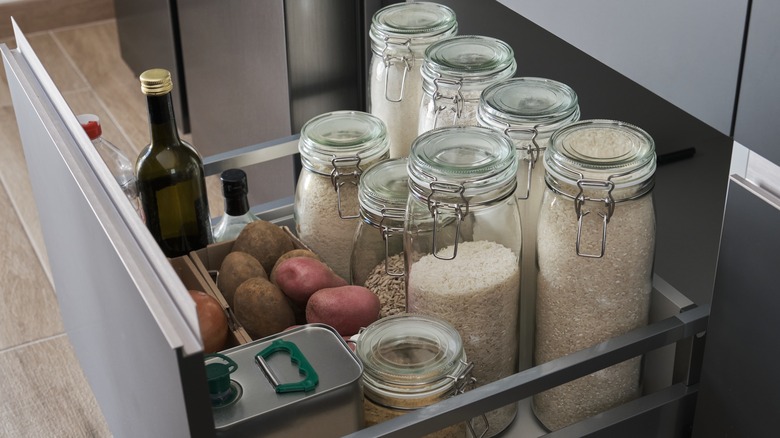9 Tell-Tale Signs Your Potatoes Have Gone Bad
Potatoes are a pretty amazing type of produce. Not only are they incredibly versatile — you can boil them, mash them, bake them, fry them, and more — but they're also packed full of nutrients including potassium, vitamin C, vitamin B6, magnesium, and iron. Additionally, they're calorie-dense, relatively inexpensive, and hardy crops. Another bonus is that you can store potatoes for a long time. Unfortunately, if they start to go bad, you'll need to toss them out pretty fast.
Potatoes may go bad if you don't keep them in the right conditions, but they can also go bad if they're infected with a fungus or bacteria, which can happen while they're growing. While you should look for this when buying produce at the store, sometimes you can't tell until after you've brought them home. There are also times when a potato may look rough but is totally fine. So, how can you tell if your potato has gone bad and when is it salvageable? I hit up my local farmer's market and talked to some local purveyors to find out.
Your potatoes have sprouted...a lot
If you've kept a potato for a little bit, you may have noticed that the eyes have started to sprout. This is normal; it's how potatoes grow new plants. Potatoes are a type of plant called tubers, and they reproduce by sprouting new plants from their buds. Usually this happens in the spring and summertime while the potatoes are still in the ground, but if the conditions are right in your pantry, the potatoes can get confused and start sprouting there instead.
For this to happen, the potatoes need three things: warmth, light, and humidity, and they can sometimes find that in your home. However, a potato that's just started to sprout isn't necessarily a lost cause. "All you need to do is cut off that area," says Nicki Kathman, a local Minnesota gardener and freelance landscaper. And you need to cut those parts off, as potatoes contain two toxic glycoalkaloids. Glycoalkaloids are compounds that can make you sick, and while the white part of the potato has hardly any, you'll find a lot more in the sprouts.
So if a few sprouts are fine, why put this sign at the top of the list? A few reasons. First, if a potato has gotten to the point where there are multiple sprouts, there could be other things wrong with it. Second, these sprouts are one of the most obvious signs that a potato is changing. If you notice several sprouts on your potato, take a few moments to assess the spud and make sure there aren't any other issues.
They feel soft and squishy
So, what are some more subtle signs that a potato has gone bad? The first sign that Linda Colbjornsen, a local gardener who sells her produce at area farmer's markets under the name "Grandma's Garden," looks for is a change in texture. "They get soft," she explains. Potatoes can start to get a little soft due to moisture loss, so what you really need to look out for is squishiness and mushiness.
Potatoes should be tossed "if they have bruises that turn to mush," says Nicki Kathman. This indicates that the potato is rotting or spoiling, which can happen when produce is exposed to microorganisms in the air, like mold, yeasts, and bacteria. It can happen more quickly when a potato is damaged, like when it gets a cut or a bruise.
A slightly soft potato is still okay to eat, but you should use it up quickly. However, a potato that has mushy spots (or is totally mushy) is no good anymore and should be tossed — but if you're a gardener, there is another option. "The cool thing about potatoes," Kathman says, "is you can cut the bad part off a potato, and as long as there's an eye on it, you can plant it." If you've got a green thumb and some space for planting, try growing your own!
The skin has become wrinkly
Potatoes are 80% water, and when stored in a dry area, start to lose some of that water content. That can lead to a little softness, as we mentioned above, but also cause the skin to wrinkle. A small amount of this is usually okay, but if your potatoes are shriveled and wrinkly all over, it's time to toss them out.
Potatoes get wrinkly and shriveled because their insides have started to decay. As this happens, the skin around the potato isn't pulled tight anymore and starts to fold in on itself. Decaying potatoes aren't safe to eat; they're full of microorganisms and glycoalkaloids that can make you sick, no matter what way you cook the potatoes. Additionally, it probably won't taste very good; decaying potatoes often taste bitter or even sour.
To prevent your potatoes from decaying too fast and getting wrinkly, store your potatoes properly. If you notice any squishy or wrinkly potatoes in your batch, throw them out right away to prevent contamination.
Liquid is leaking everywhere
Have you ever picked up a bag of potatoes from your shelves and noticed they leave a wet spot behind? If so, that means your potatoes are getting leaky and their time is up. To clarify, we're not talking about when you cut into a potato and water comes out. As we mentioned above, potatoes are mostly water, and when you slice into them you're breaking the cell walls, releasing some of that moisture.
But if the potatoes are leaking while still whole, that's a "whole" other topic. There are a couple of reasons that this happens, but in both cases, the potatoes aren't edible anymore. The first is due to the potato naturally decaying, and you'll usually notice other signs, like the squishiness or shriveled skin, as well as a bad smell when this is the case.
The second is due to a fungus or pathogen. For example, Pythium fungi often cause leaking and a condition called shell rot. When the potato becomes infected with this fungi, the fungi start to break down the inside of the potato, liquifying the interior until all that's left is the outer shell. This infection can spread quickly and usually also comes with a sharp smell that goes from vinegary to putrid as the potato breaks down. It's usually not possible to tell if a potato has this fungus until after it has been harvested.
The smell turns terrible
There are several different types of potatoes, but they all have a somewhat similar scent. "I think of it as starchy," says Nicki Kathman, but it can also be described as earthy or neutral. If your potato smells bad, however, like something sour or rotten, it's no longer good and needs to be tossed.
You may notice a few different types of smells once your potato starts to go bad, and the type of smell can indicate what's wrong. As potatoes, like anything once living, start to break down, they produce gasses. These gasses are responsible for the rotten, putrid smell as potatoes decay. In large quantities, these gasses can actually be lethal and are thought to be responsible for the death of an entire family in Russia in 2013.
As we mentioned above, rot caused by the Pythium fungi usually starts as a vinegary smell and builds to a rotting fish smell, sometimes described as the smell of rotting fish. Another fungus, Phytophthora erythroseptica, causes a condition called pink rot. Pink rot is also referred to as "blight," and this fungus is what killed the potato crops in the Irish famine. If your potato is infected, you'll notice when you cut it, but before that, you may pick up on a scent that smells something like formaldehyde or ammonia.
It's been overtaken by mold
In general, if you find mold on your food, it's best to throw it out. However, the jury seems to be out on whether this is necessary with firm fruits and vegetables. With softer things, like bread, the mold spores can penetrate deep into the food even if you can't see them, which is why you shouldn't just cut the mold off old bread. But with harder foods like carrots and, of course, potatoes, there's an argument that the mold has a harder time pushing through.
This is a point of contention as far as potatoes are concerned, as some suggest it's possible to remove the mold and area around it,while others suggest the spores can spread internally, meaning you should toss the potato. The United States Department of Agriculture (USDA) seems to agree in general, stating that "When a food shows heavy mold growth, 'root' threads have invaded it deeply. That said, it does not list any specific recommendations for potatoes.
In general, it's better to err on the side of caution. Some molds can make you sick, and others can cause allergic reactions in some people. If your potato has a little mold, it could be okay, but if it's starting to look like a dandelion gone to seed or a "Star Trek"-esque tribble, you're definitely going to need to throw it out.
The skin has strange spots
You're rarely going to find a potato that's perfectly consistent all the way around. However, there are some things to look for on the outside of a potato that indicates that the potato isn't healthy and is no longer safe to eat.
We've already mentioned potatoes with Pythium turn squishy, leaky, and smelly. These often start with spots on the outside, as the fungi typically enter through cuts or abrasions on the skin of the potato. These spots aren't bruises, but rather legions that usually look gray or brown. Potatoes with pink rot, meanwhile, will have skin that starts to darken and may develop black lesions, however, this is less obvious to spot than potatoes with Pythium .
Dry rot, caused by types of Fusarium fungi, is usually identifiable by a spot of crumbly brown rot on the outside, sometimes covered with a white fungus. You'll also want to avoid potatoes affected by the Alternaria fungi, which usually have shallow, dry lesions that are grey or black. However, if you notice your potato has a silvery "scab" over the skin, you can still eat them. These scabs are caused by fungi, and although they may look kind of gross, they're find to use if you peel them first.
The insides don't look right
Several infections cause potatoes to look fine on the outside but once you cut inside, it's clear something is wrong. For example, a potato with soft rot may look okay on the outside, but once you cut it open you'll notice a hollow space, usually lined in gray, surrounded by a brown spot. Another type of wet rot causes brown spots as well, but this type also has black flecks and grainy, mushy tissue. Potatoes with Phytophthora infections usually look completely normal on the outside, but on the inside, they have a dry, reddish-brown rot spreading from the skin inward.
As we mentioned above, potatoes contaminated with Pythium will usually be squishy and leaky. Inside, you'll find more of the same: a squishy, rotten brownish-black spot inside and along the edge. Those with pink rot, or blight, are a little unique in that they don't look radically different when sliced, although you will still notice a slightly darker spot on the inside. After 10-20 minutes, that spot turns a rich shade of pink. After a little bit longer, the pink will turn brown, then black.
They've gone green
There's an old wives' tale that green potatoes will make you sick or even kill you. Like many such tales, there's a grain of truth there, or in this case, a whole lotta truth. Remember the two glycoalkaloids we mentioned earlier? These are called solanine and chaconine, and they're present in nightshades like potatoes, tomatoes, eggplants, and, of course, the deadly belladonna. These compounds can cause awful gastrointestinal symptoms, including cramping, vomiting, and diarrhea, and cannot be cooked out of the potatoes.
Generally, potatoes, tomatoes, and eggplants don't have very much solanine and chaconine in them. In fact, you'd have to eat about 12 eggplants in one sitting to feel the effects of solanine poisoning. However, green potatoes have a higher concentration of the toxin, although interestingly, it has nothing to do with the color.
When potatoes are exposed to light, the amount of glycoalkaloids increases, as does the chlorophyll, which is what makes the potatoes green. So while the green doesn't cause the poisoning, or vice-versa, increased chlorophyll in a potato usually means increased glycoalkaloids as well. As a result, you can't just cut off the green parts; it's best to just throw the whole thing out.
How to keep your potatoes fresh longer
As you may have guessed, potatoes will do best in a cool, dry, dark place. They can last a long time this way. As Nicki Kathaman reminds me, "People back in the day used to take and put potatoes and carrots and stuff like that in root cellars because they would last them the whole entire winter."
Store your potatoes dry; don't wash them until you're ready to use them, and keep the area ventilated. Keeping them in a dark area will help prevent the development of solanine and chaconine and prevent sprouting. If you're planning to boil or bake the potatoes, the ideal temperature to keep them at is about 38 F, but if you want to fry them, they can go up to 45 F. Potatoes do best in breathable containers, and shouldn't be stored with produce like onions that emit gasses that can accelerate sprouting and rotting. Additionally, check your potatoes periodically and remove any that have wet spots, mold, or signs of rot.
